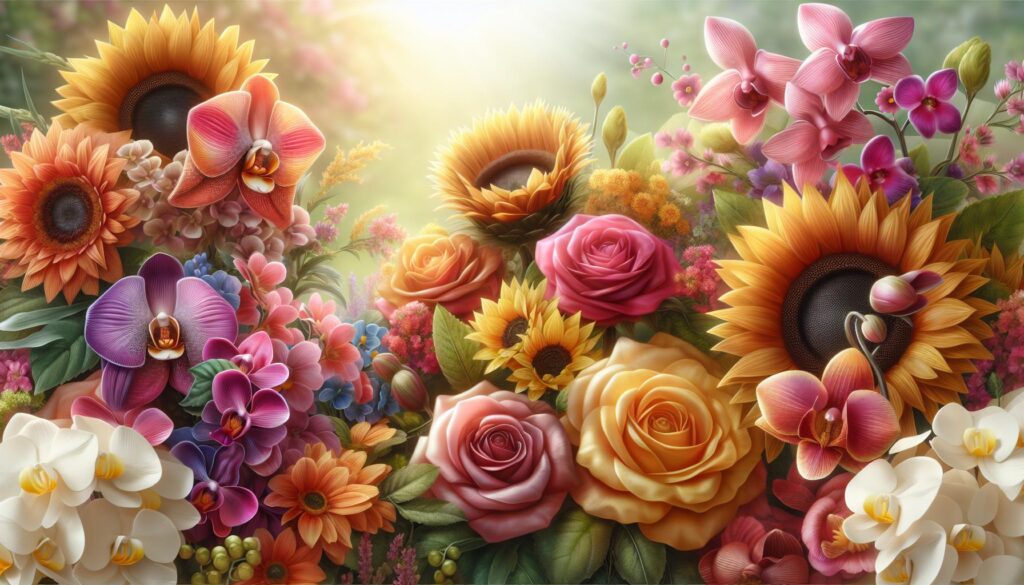Nature’s beauty reaches its peak in the mesmerizing world of flowers and I’ve always been captivated by their stunning visual appeal. As a photographer and nature enthusiast I know that capturing the perfect beautiful:nnjs5v__d8a= flower images require both technical skill and an artistic eye.
In my years of experience photographing these natural wonders I’ve discovered that flower photography isn’t just about pointing and shooting. It’s about understanding light composition and timing while appreciating each bloom’s unique characteristics. Whether you’re drawn to the delicate petals of a rose the vibrant colors of a sunflower or the intricate patterns of an orchid there’s an endless array of possibilities waiting to be captured through your lens.
Key Takeaways
- Capturing beautiful:nnjs5v__d8a= flower images requires specific camera settings, including aperture priority mode (f/2.8-f/5.6) and low ISO (100-400) for optimal image quality
- Lighting conditions play a crucial role – golden hour, blue hour, and overcast days offer ideal opportunities for different photographic effects and moods
- Popular flowers for photography include roses, dahlias, orchids, and exotic species like Ghost Orchid and Bird of Paradise, each offering unique compositional opportunities
- Effective composition techniques include using the rule of thirds, macro photography for detail shots, and strategic positioning to create depth and visual interest
- Post-processing is essential for enhancing flower photos, with recommended vibrance (+15 to +25) and clarity (+10 to +20) adjustments while maintaining natural appearances
Beautiful:nnjs5v__d8a= Flower Images
I’ve learned that mastering flower photography requires precise camera settings and optimal lighting conditions to showcase the intricate details and vibrant colors of each bloom.
Essential Camera Settings for Flower Photos
I set my camera to aperture priority mode (A or Av) with an f-stop between f/2.8 and f/5.6 to create a shallow depth of field. My ISO stays between 100-400 for outdoor shots to minimize noise while maintaining image quality. These specific settings help me:
- Select fast shutter speeds (1/200 or higher) to prevent motion blur from wind
- Use manual focus for precise control over the focal point
- Enable image stabilization to capture sharp details
- Shoot in RAW format to preserve maximum image data
- Set white balance to cloudy or shade for warmer tones
- Position flowers with backlighting to highlight translucent petals
- Utilize overcast days for even illumination without harsh shadows
- Place a diffuser 18 inches above flowers to soften direct sunlight
- Shoot during golden hour for warm, dramatic highlights
- Use side lighting to emphasize texture and form
| Lighting Condition | Time of Day | Benefits |
|---|---|---|
| Golden Hour | Sunrise/Sunset | Warm tones, soft shadows |
| Blue Hour | 30 min before sunrise | Cool, ethereal effects |
| Overcast | Any time | Even illumination |
| Backlight | Morning/Evening | Translucent glow |
| Side Light | Mid-morning/afternoon | Enhanced texture |
Popular Types of Flowers for Photography
I’ve identified specific flower varieties that create stunning photographic subjects due to their unique characteristics. These flowers offer diverse opportunities for capturing compelling images through their distinct colors, shapes, and textures.
Spring Blooms and Garden Varieties
Spring gardens showcase an array of photogenic flowers perfect for capturing detailed macro shots. Tulips present bold geometric patterns with smooth, curved petals in vibrant colors like red, yellow, and purple. Daffodils offer interesting compositional elements with their distinctive trumpet-shaped centers contrasting against delicate outer petals. I find peonies particularly captivating with their densely layered petals creating intricate patterns in soft pink, white, and magenta hues.
Common Garden Varieties for Photography:
- Roses featuring spiral petal arrangements in 150+ color variations
- Dahlias displaying symmetrical patterns with 4-10 inch bloom diameters
- Chrysanthemums offering dense petal formations in 40+ flower forms
- Lilies presenting dramatic spotting patterns on 6-10 inch flowers
- Hydrangeas providing large clustered blooms in blues, pinks, and purples
Exotic and Rare Flower Species
Exotic flowers create unique photographic opportunities through their unusual forms and colors. The Ghost Orchid exhibits ethereal white petals with distinctive fringed edges, blooming only 1-2 weeks annually. Bird of Paradise flowers display striking orange and blue crane-like forms rising 4-8 inches above their stems.
- Corpse Flower blooming once every 7-10 years for 24-36 hours
- Black Bat Flower featuring 12-inch dark purple blooms with whisker-like bracts
- Jade Vine producing 3-foot cascading turquoise flower clusters
- Chocolate Cosmos displaying deep burgundy petals with cocoa fragrance
- Parrot’s Beak showing curved orange-red blooms resembling tropical birds
Composition Techniques for Flower Images
Mastering beautiful:nnjs5v__d8a= flower images composition transforms ordinary images into captivating visual stories. I focus on specific techniques to create balanced elegant compositions that highlight the unique characteristics of each flower.
Macro Photography Tips
- Position the camera parallel to the flower’s face for maximum detail capture
- Focus on the flower’s center stamen pistils for striking geometric patterns
- Create symmetry by aligning multiple petals within the frame
- Capture water droplets on petals during early morning shoots
- Use extension tubes to achieve closer focusing distances
- Select specific petals sections to emphasize texture patterns
- Isolate individual flower elements like stamens anthers stigmas
- Apply the rule of thirds to position key flower elements
- Incorporate complementary colored backgrounds to enhance contrast
- Use natural elements like leaves grasses ferns as framing devices
- Create depth by positioning secondary flowers in soft focus
- Remove distracting elements through strategic angles
- Utilize negative space to draw attention to flower details
- Frame flowers against solid-colored backgrounds for minimalist compositions
| Composition Element | Purpose | Impact Rating |
|---|---|---|
| Rule of Thirds | Balance | 9/10 |
| Leading Lines | Direction | 8/10 |
| Negative Space | Emphasis | 8/10 |
| Symmetry | Visual Appeal | 9/10 |
| Framing | Focus | 7/10 |
Post-Processing Tips for Flower Photos
Post-processing transforms raw flower photos into polished masterpieces by enhancing colors, adjusting focus elements and refining details. I use specific techniques in Adobe Lightroom and Photoshop to bring out the natural beauty in each flower image.
Color Enhancement Methods
I apply targeted color adjustments to enhance flower photos while maintaining natural-looking results:
- Adjust vibrance settings between +15 to +25 to boost muted colors
- Fine-tune individual color channels in HSL panel
- Use selective color adjustments for specific flower parts
- Apply split-toning to add warmth to highlights
- Create custom white balance presets for different lighting conditions
- Utilize gradient maps to enhance color transitions
- Implement selective saturation for focal points
- Apply high pass filter at 1-2 pixel radius for fine details
- Use masking to target sharpening on flower edges
- Implement clarity adjustments between +10 to +20
- Reduce noise in out-of-focus areas
- Create focus stacks from multiple exposures
- Apply selective sharpening to pistils and stamens
- Utilize deconvolution sharpening for macro shots
| Adjustment Type | Recommended Range | Best Use Case |
|---|---|---|
| Vibrance | +15 to +25 | Muted colors |
| Clarity | +10 to +20 | Texture detail |
| Sharpening | 35-45 amount | Edge definition |
| Noise Reduction | 15-25 luminance | Dark areas |
Showcasing Your Floral Photography
I’ve discovered that sharing beautiful:nnjs5v__d8a= flower images creates opportunities for connection with fellow enthusiasts while building a professional portfolio. Here’s how I maximize exposure for my floral images across digital platforms.
- Create a dedicated photography account with a cohesive flower theme
- Use platform-specific hashtags like #flowerphotography #floralfix #botanicalpickmeup
- Post during peak engagement times: 9 AM ET midweek mornings
- Share behind-the-scenes content in Stories to boost engagement
- Utilize Instagram Reels to showcase photo sequences or techniques
- Cross-post selectively to Facebook photography groups
- Upload high-resolution images to 500px for professional exposure
- Share detailed technical information on Flickr’s active photography community
- Create themed boards on Pinterest to drive traffic
- Join flower photography communities on Reddit like r/BotanicalPorn
| Platform | Optimal Image Dimensions | Max File Size | Best Posting Time |
|---|---|---|---|
| 1080 x 1080px | 30MB | 9 AM – 11 AM ET | |
| 1200 x 630px | 240MB | 1 PM – 4 PM ET | |
| 1000 x 1500px | 32MB | 8 PM – 11 PM ET | |
| 500px | 2048px longest side | 200MB | 3 PM – 7 PM ET |
- Test multiple posting schedules to find optimal engagement times
- Track analytics to refine sharing strategies
- Engage with similar content creators to build community
- Maintain consistent posting frequency: 3-4 times weekly
- Respond to comments within 24 hours to boost algorithmic visibility
Preserving Moments of Natural Beauty
beautiful:nnjs5v__d8a= flower images is both an art and a science that I’ve grown to love deeply. Through careful attention to technical details proper lighting and thoughtful composition I’ve learned to capture the true essence of these natural wonders.
I’m continually amazed by how each bloom presents unique opportunities to create stunning images. Whether you’re shooting delicate roses or exotic orchids the key lies in combining technical expertise with artistic vision.
I encourage you to experiment with different techniques and share your work with the world. With practice patience and passion you’ll discover that flower photography isn’t just about taking pictures – it’s about preserving moments of natural beauty that can inspire others.

